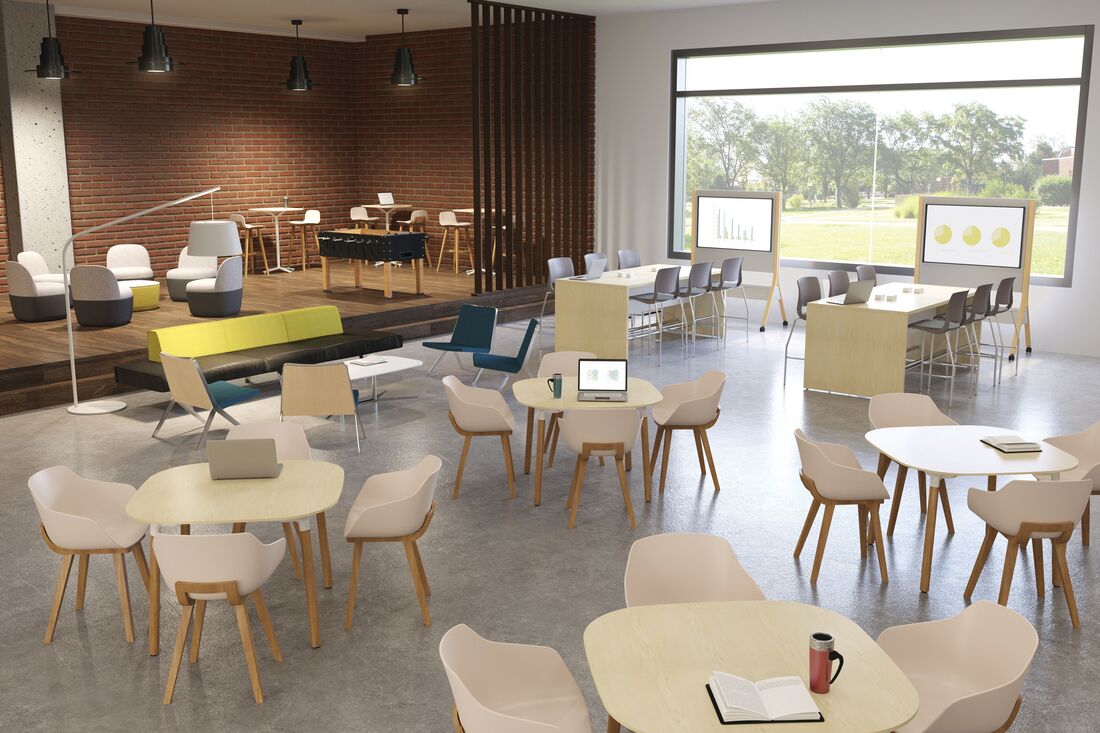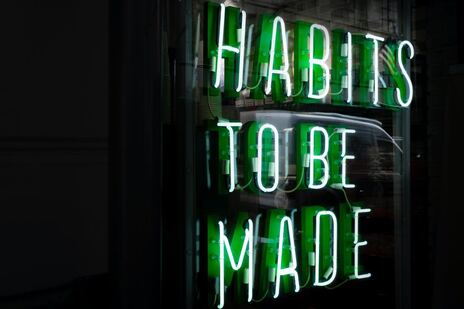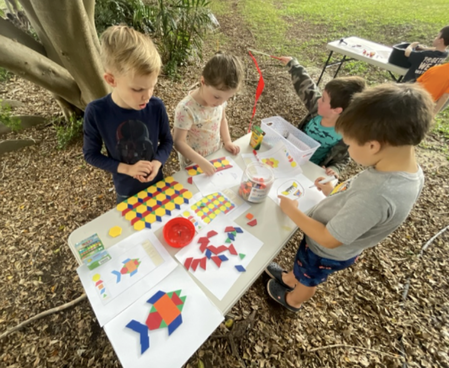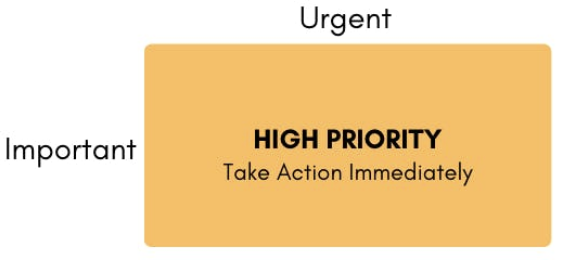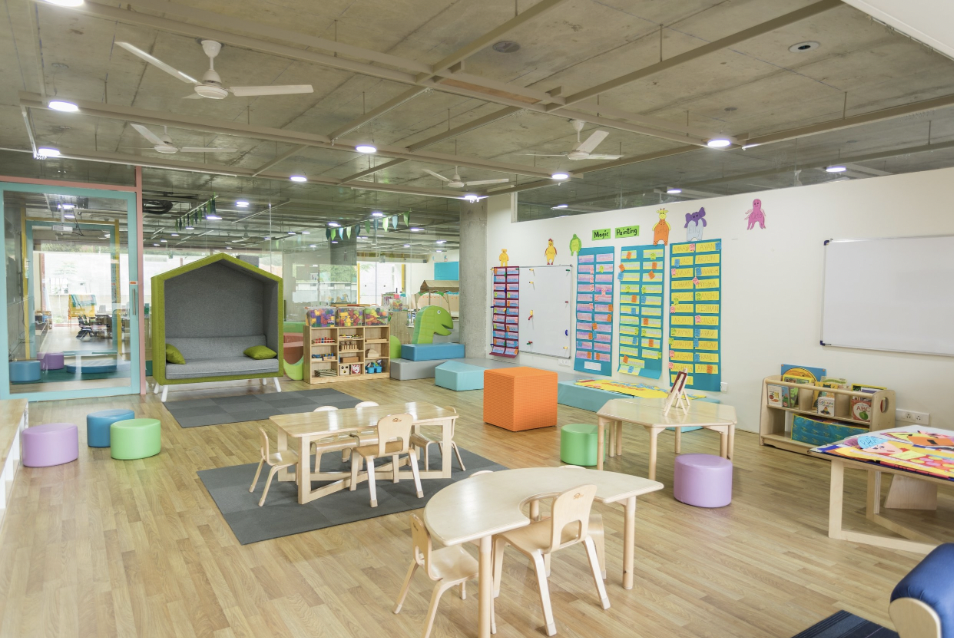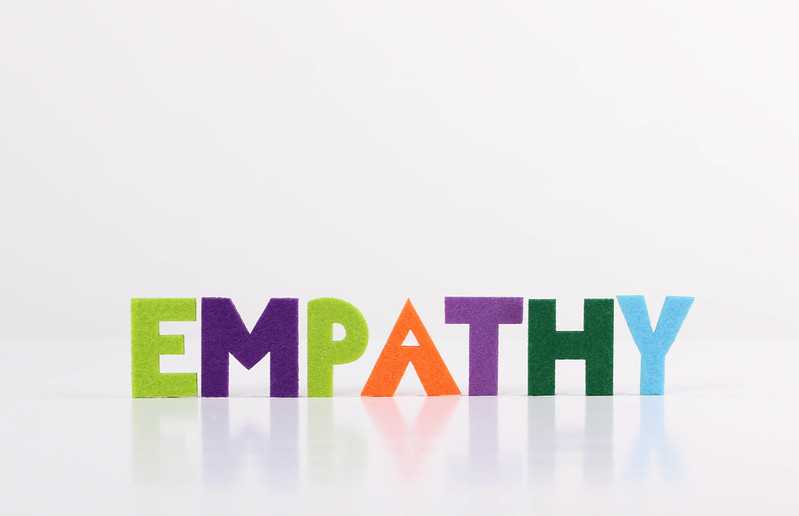|
This post was co-authored with Naomi Church of Growing Minds Consulting.
At any point during a school year, teachers can make necessary changes in their classroom spaces. This could be when a new student joins or leaves the group, maybe new furniture has arrived, or perhaps the teacher just needs to change things up for their learners. For successful teaching and learning experiences in the physical classroom space, the space must be clutter-free (Marshfields) and student-centered for increased creativity and decreased unnecessary stimulation. In this blog post, we'll explore how to purposefully design your classroom space to foster student engagement, agency, and ownership, while also ensuring efficiency and productivity. 1. Triple P Framework: Purpose, Priority, Pare Down Before diving into the nitty-gritty of classroom design, it's essential to adopt a Triple P framework:
2. Student Work Arrangement Consider how you want your students to work within your classroom space. The arrangement of desks and seating can greatly influence the dynamics of your classroom. Options to consider include:
3. Built-in Furniture and Storage Do you have built-in furniture in your classroom? Built-in furniture can maximize space and create a cohesive and functional environment. Consider the following:
4. Minimize Distractions A cluttered classroom can be a breeding ground for distractions. Keep only what is necessary in the classroom:
5. Accessibility and Exploration Lastly, ensure that your classroom space is accessible for exploration and learning. Thoughtfully chosen resources and community-based materials can enhance the educational experience:
We have the power to shape the learning environment and influence student engagement, agency, and ownership every day, so every day, make a conscious effort to design your physical classroom space with purpose, prioritize essential elements, and pare down distractions. Create a space that empowers students to work collaboratively or independently, while also ensuring that it remains accessible and conducive to exploration. There is no one “right” way to design a classroom. Classroom design is intentional and based on the learning experience you seek to create. We are proposing a thoughtful approach to design so that your physical space can be a support in helping you reach your educational objectives and increase student engagement and achievement. The learning environment should support your work, not hinder it. With a well-designed classroom, you can set the stage for a successful academic year and create an environment where both you and your students thrive.
0 Comments
10/6/2023 0 Comments Set Up for SuccessBy Christine and Tammy
As educators, we constantly strive to create an environment conducive to learning. The beginning of a new school year is the perfect opportunity to establish routines, create positive habits, declutter your physical space, and hone your tech skills. This blog post will guide you through these steps that form the foundation for a successful academic year. Importance of Routines Routines are crucial in creating a structure within which students can thrive. They enable efficient classroom management, smooth transitions, and foster positive team relationships. Regular routines like daily check-ins, making time for a break in the staff lounge, and scheduling time for trying new platforms and incorporating them into lessons can make a significant difference in your teaching experience. Creating Positive Habits Developing habits that align with your priorities is essential. Remember, it takes more than two months to build a new habit, so persistence is key. Various strategies like habit stacking, chunking your habits, and having an accountability partner can facilitate the process. These habits not only keep you pared down but also help to save time. Decluttering Your Physical Space Decluttering your physical space is another crucial aspect of setting up for success. A clean, organized environment enhances focus and productivity. You can start by taking inventory of your space, organizing pick-up events, and developing strategies to manage reluctance. Remember the Triple P's: Purpose, Priorities, Pare Down. This approach can make the process of decluttering manageable and effective. Develop Tech Skills With the increasing integration of technology in education, developing tech skills has become more important than ever. Scheduling time to learn and experiment with new platforms and incorporating them into your lessons can enhance the learning experience for your students and streamline your teaching process. Time Savers Time is a precious resource in the educational sphere. Evaluating your habits and routines, auditing your time, and having a varied list of strategies can help you make the most of it. Remember, it's essential to balance work and personal life, so don't hesitate to 'go home' when you need to. Co-written by Nicole and Tammy
We had the privilege of writing this piece for Naomi Church of Growing Minds Consulting, which was featured on her blag last week. We wrote this piece as a bridge between our areas of expertise - learner agency and Universal Design for Learning. The ultimate goal of UDL is to create expert learners who are purposeful & motivated, resourceful & knowledgeable, strategic & goal directed. We can only start and assist learners along their journeys by giving them agency and ownership over their own learning. Isn’t that what we want for our students - for them to become critical thinkers and problem solvers to prepare them for careers in the future work force? In today's rapidly evolving educational landscape, it has become crucial to recognize and nurture learner agency. Gone are the days of passive learning, where students were mere recipients of knowledge. Instead, empowering students to take an active role in their learning journey has emerged as a transformative approach. In this blog post, we will explore the concept of learner agency, its significance in education, and the reasons why providing students with opportunities to practice agency in the classroom is essential. Understanding Learner Agency - Learner agency refers to the capacity of students to make choices and take ownership of their learning. Students have the voice and choice to set goals, and the responsibility to make decisions, making them active participants in the learning process. By fostering learner agency, educators encourage students to become self-directed learners, responsible for their own growth and development. Encouraging Intrinsic Motivation - When students have opportunities to have agency to construct their learning, they are more likely to be intrinsically motivated to learn. By allowing them opportunities to construct their learning; ie. to choose topics of interest, design projects, and set personal goals, educators tap into their natural curiosity and passion. This intrinsic motivation fuels a deep sense of engagement beyond mere compliance, making learning more enjoyable and meaningful for students. Developing Critical Thinking and Problem-Solving Skills - Learner agency promotes the development of critical thinking and problem-solving skills, which are essential for success. When students have agency, they are presented with opportunities to identify challenges, analyze information, and generate innovative solutions. They may even discover problems others haven’t thought of. This process keeps learners actively thinking and constructing knowledge. Fostering Independence and Autonomy - Providing students with opportunities to practice agency nurtures their independence and autonomy. By making decisions about their learning, students become more self-reliant and develop a sense of responsibility. They learn to manage their time, set priorities, and take ownership of their successes and failures. These skills are invaluable for lifelong learning and personal growth. Enhancing Creativity and Self-Expression - Learner agency encourages creativity and self-expression. When students have the freedom to explore and experiment, they can unleash their creative potential. Whether it's through choosing presentation formats, pursuing alternative approaches, or expressing ideas in unique ways, agency allows students to showcase their individuality and develop a sense of identity as learners. Cultivating a Growth Mindset - Learner agency nurtures a growth mindset in students. By encouraging them to take risks, embrace challenges, and learn from setbacks, educators help students develop resilience and a belief in their ability to learn and improve. With agency, students understand that mistakes are valuable opportunities for growth, and they become more willing to persist and persevere. Learner agency is a powerful educational concept that empowers students to become active, self-directed learners. By providing opportunities for students to practice agency in the classroom, educators can unleash their potential, foster intrinsic motivation, develop critical thinking skills, and cultivate independence. As we adapt our teaching practices to meet the needs of our students, embracing learner agency is not only important but also imperative for preparing students to thrive in a complex and ever-changing world. Let us prioritize learner agency and create classrooms where students take the reins of their education, paving the way for a brighter future. In the world of education, simplicity can be a rare commodity. Teachers often find themselves overwhelmed with a multitude of tasks, responsibilities, and objectives. Amidst this chaos, Christine and I came up with a type of beacon of clarity known as the Triple P Funnel, a powerful concept that forms the foundation of our book and offers a practical approach to simplify and streamline the complex world of education. The Triple P Funnel: Purpose, Priority, Paring Down So, what exactly is the Triple P Funnel, and why is it crucial for educators? The Triple P stands for Purpose, Priority, and Paring Down. These three essential elements serve as guiding principles to help educators navigate the challenges they face daily. 1. Purpose: The overarching question we should always ask is, "What are we doing here?" Purpose is about understanding the true meaning and significance of our actions in the context of education. It's about defining our goals and objectives clearly, ensuring that every task and decision aligns with this central purpose. 2. Priority: Once we have a clear sense of purpose, the next step is to identify our priorities. Priorities may vary depending on one's role and specific goals, and they can change over time. It's essential to recognize and focus on the most critical tasks and objectives that contribute directly to fulfilling our purpose. 3. Paring Down: Paring down is the process of eliminating unnecessary distractions and tasks that do not align with our purpose or priorities. It involves decluttering our professional lives, streamlining our workflow, and staying laser-focused on what truly matters. Why the "Triple P"? You might wonder why we chose to call it the Triple P Funnel and if we really need more educational jargon. The answer is that this framework is not jargon; it's a practical and intuitive way to approach complex challenges in education. The Triple P Funnel provides a visual representation of how purpose, priority, and paring down work together to simplify and streamline the decision-making process. The Urgent-Important Matrix In the education world, everything often feels urgent, making it challenging to identify priorities. To address this, we introduce the Urgent-Important Matrix. This simple tool helps educators categorize tasks into four quadrants: **Urgent and Important**: Tasks that require immediate attention.
- **Important but Not Urgent**: Tasks that are significant but can be planned and scheduled. - **Urgent but Not Important**: Tasks that demand immediate action but don't contribute to long-term goals. - **Neither Urgent nor Important**: Tasks that can be safely eliminated or delegated. By using this matrix, educators can focus their efforts on the tasks that fall into the "Urgent and Important" category, ensuring that they are always aligned with their purpose and priorities. Applying the Triple P Funnel Across Education Domains Let's explore how the Triple P Funnel can be applied to various aspects of education: 1. Decluttering Physical Spaces: When organizing classroom or workspace, educators can start by defining the purpose of each area. Then, they determine the priorities for items and furniture within that space, finally paring down unnecessary items that do not serve their purpose or priorities. 2. Decluttering the Curriculum: Educators can evaluate the purpose of their curriculum and assess whether it meets the needs of their students. Prioritizing essential components and removing non-essential elements ensures that the curriculum aligns with its purpose effectively. 3. Assessment Strategies: Purpose-driven assessment begins by asking, "What do we want to assess, and why?" Once the purpose is clear, educators can establish priorities for assessment methods and tasks, ultimately paring down assessments to focus on meaningful outcomes. In the complex world of education, the Triple P Funnel offers a valuable framework for educators to simplify their decision-making processes. By constantly revisiting their purpose, identifying priorities, and paring down unnecessary tasks, educators can stay focused on what truly matters and make a significant impact on student learning. The Triple P Funnel is not just another piece of educational jargon; it's a practical tool that can transform the way educators approach their roles, making their work more purposeful and effective. 8/8/2023 0 Comments Color Can Be ClutterThis blog post written by Tammy Musiowsky-Borneman and Naomi Church, and was originally posted on Growing Minds Consulting. 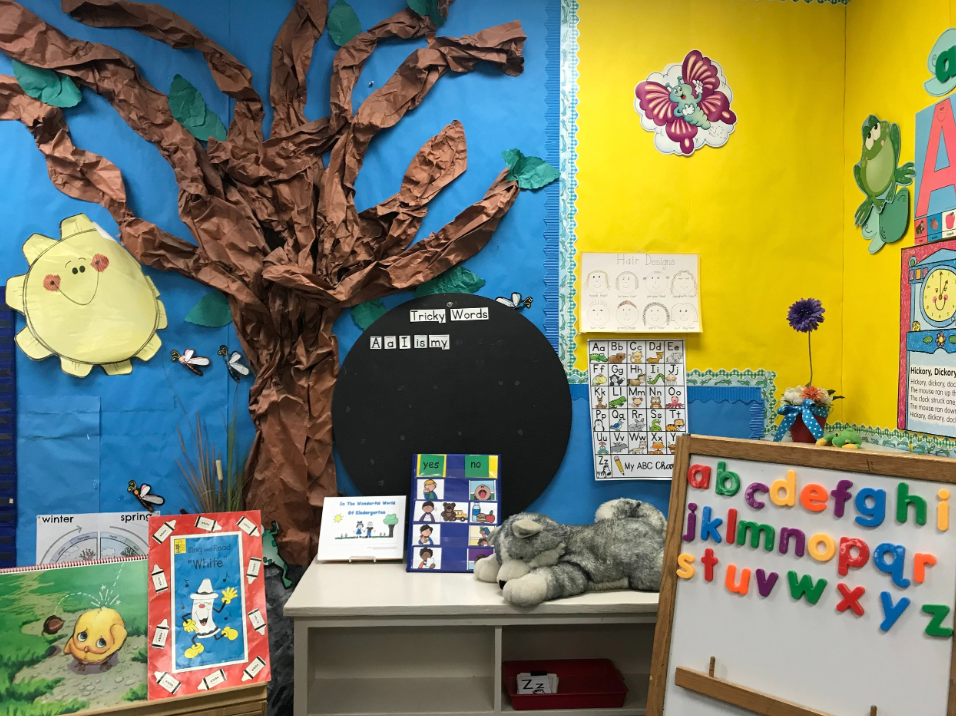 Imagine walking into a classroom where each bulletin board or wall was a different color. Not just any color, but bright yellow or red? Have you been in this room, or even set your room up in this way? Have you been in a classroom where it looks like the teacher store exploded? We taught with experienced teachers who seemed to keep decor from all of their previous years of teaching and felt the need to display it all. We have also seen classrooms with all the cute, laminated posters that students never seem to use effectively. We are not advocating for boring and uninspired classroom spaces! We are suggesting that, as educators, we are responsible for creating environments in which our learners are able to find success. We must design without barriers to learning. Creating access to an environment in which all learners feel safe and ready to learn is imperative…and it doesn’t happen by accident. Using principles from Universal Design for Learning (UDL) can support teachers in creating a space that is conducive to learning. UDL Checkpoint 7.3 speaks to minimizing threats and distractions. Oftentimes this is thought of in terms of classroom culture and risk level, but it can absolutely apply to visual distractions as well. Three Considerations When Adding Color to Your Classroom
Lighter shades are “friendlier” while darker shades are more somber. Choose colors based on the mood you are trying to set within the space. Bright colors can be overwhelming or distracting especially when many different colors are in the same space. Three Questions to Ask Yourself When Considering Colors
Creating a conducive learning environment through purposeful use of color is crucial for learners. While vibrant colors can be visually appealing, excessive and/or conflicting colors may hinder learning by overwhelming learners. Thoughtful use of color to evoke appropriate moods and emotions can enhance focus and productivity. Recognizing UDL principles supports the idea that less is more. By considering the impact of colors, or the absence of it, on learners' emotions and attention, teachers can strategically design classrooms that optimize the learning journey and help students thrive.
Resources & References:Investigating the Impact of Environmental Factors on Learning The Psychology of Color Why Do We Feel the Need to Fill Empty Spaces? The holiday season can be very stressful for a lot of reasons. Family, travel, money, illness.
It's easy to get sucked into an abyss of all the things you feel like you have to or need to do. Here are three ways we can think about our circumstances differently, which can help us manage all that the season brings. 1. Reframe how you view your to-do's. Instead of saying, "I have to do this..." or "I need to get..." try being a little kinder to yourself. Telling yourself that you have to or need to do something can create a sense of urgency and unnecessary perceived stress Instead, try saying, "I get to go to..." to frame the to-do list in a positive ways. Perhaps this will even help you remove some items from your list, just by changing the way you think about them. 2. Ask yourself some questions. You know I love a question stream! Try asking:
3. Spend time instead of money. If you are feeling financial and time pressure, offer spending time together with your people over using your time to find just the right gift. Or maybe you decide to go to a concert or a nice dinner together. Spending money on experiences together can relieve some of that pressure you feel. Still unsyre about the holidays? Step away from your device and give yourself sometime to determine what is most important for you to focus on during the season. Your people will appreciate your thoughtfulness, however you decide to spend your time, money, and energy. 11/14/2022 0 Comments Less is MoreIt’s easy to think that the more we take on in our professional or personal lives, the more successful or fulfilled we will feel. We think to ourselves, “I can squeeze a little more out of an hour here”, or “I’ll just work a little later tonight to finish up my to-do list.” It’s a trap we can all fall into, and before we know it, reaching a “work-life balance” feels like a totally unrealistic goal.
In our work at Professional Learning Partnerships, we aim to transform learning and leadership by leveraging key ideas from brain science that allow students and adults to thrive. One of the biggest misperceptions that people have about our brains is that we can “multitask” (doing multiple tasks that take focus simultaneously), and that “multitasking” leads to higher productivity. Research shows it’s actually the opposite – our brains aren’t actually capable of “multitasking”. Instead, our brains are “task-switching”, switching back and forth between multiple tasks that require our attention and focus, only truly allowing us to focus on one task at a time. Research shows that the more we task-switch, the more mistakes we make, the longer it takes us to do each of those tasks, and the more tired and drained we become (American Psychological Association, 2017; Betts et al., 2019). When we attempt to “multitask”, more is actually less. What would research suggest about how we actually achieve more, with better creativity, quality, and happiness? Less is more. When we are able to prioritize fewer more important goals and tasks in a day, as well as prioritize meaningful parameters for our job roles, research suggests we are more likely to accomplish those with better quality, more creativity, and more satisfaction. We have more cognitive resources to dedicate to important work and feel less drained as compared to when we stretch ourselves too thin and juggle too many responsibilities. New studies even show that the closer your cell phone is to your desk when working, the lower your working memory and fluid intelligence will be, even if you never interact with your phone at all (Ward et al., 2017)! Even the temptation to check your messages is enough distraction to impede clear thinking, attention, and productivity. The saying we use over and over again in our professional learning work with PLP partners is Less is Always More. Whether we’re guiding teachers in how to design a meaningful lesson for students, or supporting administrators in how to create an impactful presentation for their school board, or coaching a professional team on ways to maximize collaboration by clarifying roles and communication, the key concept is the same – identifying fewer priorities allows for better and faster results. When you focus on achieving a shorter set of important and meaningful goals, you’ll do it more effectively and theoretically feel more fulfilled because the work was purposeful. When you work to communicate a more concise message through teaching or presenting, the people involved will feel less overwhelmed by trying to remember or understand too much, and can more easily concentrate on your simple and important message. Some critical questions you can ask yourself to see if you can focus on less in your work are:
It can be an uncomfortable shift to downsize our mental workload because it feels like we will lose a little control, or disappoint peers, colleagues, or loved ones. Or some of the tasks we don’t like are mandatory parts of our job, and we can’t get out of them. BUT, the place we have the most agency and regain our empowerment is within the areas of our work or life that we CAN control, which is usually more than we realize. Look at the areas of your work or personal life in which you have control, and begin to think, “Where can I do less, so I get more meaning and more enjoyment from my time?” Start small. The breathing room we get back to focus on what matters most in our work (and life) helps us sustain the passion, energy, and motivation we need to do our work well in the long-run. About our guest writer: Julia Skolnik, MSEd is the Chief Learning Officer & Founder of Professional Learning Partnerships (PLP), an organization committed to transforming learning and leadership through applying key ideas from brain science in long-term partnerships with schools and districts. Julia leads the design and facilitation of research-based professional learning and coaching for educators and leaders, and cultivates sustained partnerships with a growing network of innovative districts across the U.S. Her passion for connecting the science of learning with the practice of education has continued to grow over the last 20 years working in a variety of settings including schools, research laboratories, universities, and museums. 10/1/2022 0 Comments But Who's Supporting the Work?We've been seeing more and more people preaching about "doing less in schools"... Yes I am one of them. But as I see these posts come out, I wonder who's actually doing it and supporting the work?
Embodying minimalism in your school setting and teaching life is a challenging task - one that takes time. It takes time to unpack mindsets and a development of understanding how critical this work is. We are supporting this work. We have held sessions for many educators from Halifax to Warsaw. We have worked one-to-one with teachers who want to make changes for their sanity and to improve their teaching practice. They see the value and want to do it. We are here for the journey. And it is a journey. I just read Daniel Goleman's book, Focus - a great book about getting people, leadership, and companies to the next level by choosing focus. On the final page are some words of the Dalai Lama, and they are what seem to be sticking right now because it reminds me of doing less to set our future generations up for success. "Start the task even if it will not be fulfilled within your lifetime. This generation has a responsibility to reshape the world. If we make it an effort, it is possible to achieve. Even if it seems hopeless now, never give up. Offer a positive vision, with enthusiasm and joy, and an optimist outlook." This is how we begin to change systems that negate our desire to do and be well. 8/14/2022 0 Comments Extending the NetworkWhat does it mean for us when we make additions to our professional networks?
Sometimes even attempting to "add" new people to our networks can feel overwhelming especially when we are already managing so much, and even more so as an introvert. But what if we are ready for the addition? I love the folks in my network. I am always learning from my close network. We have meaningful conversations, reflect together, and ask each other for guidance. When thinking about building out my network, I know what I can look forward because of my experience. I look forward to new branches of growth and new perspectives. New questions to ask and answer. New connections to make. New collaborations to get under way. I'm ready for the growth and I know the benefits. These are healthy outcomes of extending my network. Are you ready for further growth? 6/12/2022 0 Comments Adopting IDeasIf you’ve just wrapped up your school year, or are about to in the next few days, I know you may be feeling a couple of ways. You might be wanting to hibernate for a few days, and in this case, you may be looking for some ways to seek comfort after a trying year. Or, maybe you are the person who can detach from the year quickly and begin your summer frolic! Whichever way you chose to get your summer rolling, here is something to think about as you start your mental and time decluttering.
“Historically and culturally, minimalism tends to be represented predominantly in the lifestyles of white Scandinavian and Asian cultures. When thinking of Scandinavia and minimalism, we probably first think of architectural and furniture design [Ikea]. But it goes much deeper than this in traditional culture, as described by the Danish term hygge and the Swedish word lagom. These terms encapsulate ideals such as life balance, well-being, comfort, and enjoying life and our time. Japanese culture is known for living small, it has deeper roots in Zen Buddhist values in venerating simple lives and rejecting material possessions. Minimalist approaches have more recently been popularly adopted in many countries around the world. Furthermore, we can trace minimalist values to many different religions, philosophers, and leaders around the globe and throughout written history.” Do you think learning some ideas from these cultures can help you in decompress from your tough academic year? If so, how? We’d love to hear! 6/6/2022 0 Comments Triple P Decision MakingDo you know about our Triple P Decision-making framework? Here’s some background information and how it might help when you are trying to make well-informed decisions about what you might be introducing to students or teachers.
“When discussing ideas for this book, we knew introducing new educational jargon or acronyms that did not meet the goal of transforming to a minimalist approach would be a poor decision. Yet, we knew we needed a simple phrase that would stick in a cluttered teacher’s mind to move the work ahead. After we boiled down many of our professional conversations, as well as conversations we have had about writing this book, we were consistently coming back to three main points resulting in what we have called the Triple P questions part of our Triple P framework. 1. What is our purpose? 2. What are our priorities? 3. How can we pare down resources? Purpose: Every day we ask ourselves easy-to-answer questions. “Why am I running when my knee hurts?” Easy answer. “Why am I using this product instead of that one?” Easy again. But when we ask ourselves, “Why would I teach that?” or, “Why would I teach that in this way?” we must peel back the layers of teaching and learning, because there are so many “Why am I doing this?” questions to ask. Priority: Now, here lies a great challenge. How do you prioritize when there are just so many “things” that require attention? Go back to your purpose to help you build your prioritization muscles. Your priority will always be the well-being and learning experiences of your students. Always and forever. Remember this when your mind is swamped because we know from experience that our priorities are masked by other clutter. In schools, items for discussions are usually prioritized by time and money, not by student or teacher needs. How do you unmask these mandated compliance tasks in a short time frame while still ensuring integrity in your teaching and, quite honestly, your sanity? While the Triple P questions become more intricate when peeling back the layers, remain simple in your response: your students are your priority. Pare Down: Last but certainly not least—how does one pare down all that “stuff” so that priorities match purposes? How do you really do more with less? This may become the most challenging part of the transformation of practice. The challenge comes with letting go of things, control, and feeling overwhelmed to make space for increased efficiency, productivity, and new feelings of satisfaction and supported well-being. We will work with you through this process of letting go.” What part of the Triple P sticks out for you? How might this be helpful? The term “culture” can bring to mind various images or meanings. This can encompass anything from language or food to the arts or family structures. Ultimately, a culture is a shared set of values and practices that a group of people holds. A culture of minimalism requires members of a group, in this case, your classroom, to recognize and work toward making use of currently available resources and no more in order to best support the requirements and expectations of the community. While a minimalist culture in classrooms may seem unconventional, overly innovative, or unrealistic now, this approach is becoming more and more socially acceptable. Rather than superficially attempting to meet students’ needs by buying “things,” adding more tasks, or creating more paperwork, there is a shift to instead maximize existing resources in the community and create a lifelong practice and lifestyle of appreciation, efficiency, and sustainability.
Refocusing on your purpose in teaching assists in creating a mental space in which you can tune into your students. This helps you prioritize students and their needs, and helps pare down those non-essentials that clutter up teaching. How would creating this culture add value for you, and for your students in the upcoming year? 4/5/2022 0 Comments A New CycleThis past week - the first week of August - was a set of essential planning days for us.
This was precious time for our teacher team to begin this year’s school development cycle. Because our priorities were clear from the beginning, we used our time efficiently. In just three days, we learned about each other’s strengths and passions, AND we made significant headway in framing the learning experiences. Last year was the school’s inaugural year so some structures were not yet in place so when we were building the calendar for this academic year, we knew how important it was going to be to build in teacher work days. These days will be times to reflect on units and frame out the upcoming ones. This was a lot of fun. I love a cycle, a process. And collaboratively planning instruction should be just that. A cycle. We can never think that we can plan a year out or develop school goals once at the start of the year. Time built into the calendar is essential to help us keep our vision in focus and our priorities in line. Robin Jackson, author of the ASCD book, Stop Leading, Start Building: Turn Your School into a Success Story with the People and Resources You Already Have, tells us we need to get off the old-school hamster wheel of school improvement planning - once a year, same-ish plan, no time to reflect and revise, and then keep running on that same "improvement" plan year after year. We have to stop this damaging cycle. It wastes our time and energy and keeps us only in a lane of compliance. Whether you are the lead planner or a participant in the process, consider a new planning cycle strategy to facilitate success for your school community to avoid getting caught on that hamster wheel. 3/17/2022 0 Comments Bringing Back Joyful LearningPerhaps more than ever, schools face a multitude of challenges in meeting the needs of the students they serve. The pandemic introduced a new set of protocols for classrooms to implement, along with the myriad of responsibilities already in place for classroom teachers. Considering these many expectations, it is easy for teachers to find themselves pouring all of their energies into managing their students and learning environments. In an effort to control variables, attention can become hyper focused on to-do lists, as well as tracking behaviors, shortcomings, and predetermined outcomes. We can lose sight of the individual student, and instead focus on collective performance and outcomes. In doing so, we slowly rob our students of ownership of their learning, self-discovery, and expression, thereby stunting the natural joy in learning. And, it isn’t only the student who experiences diminished joy in this environment, so does the teacher. The more external control and lack of autonomy students feel exerted upon them, the more disengagement, dependency, apathy, and lack of motivation they feel. A perfect storm for behavioral issues to appear.
A solution to this exists. A simple, natural, human-friendly solution; make students partners in their learning journey, and infuse natural elements of play and exploration in learning experiences. Turn over some of that control and responsibility to the learner, it is their journey after all. Allow them to devise ways to connect play, exploration, and experimentation to learning targets. Consider this quote by Susanne Leslie, “Play is not more important than science, literacy, physics, or math - it IS science, literacy, physics, and math. It is the FOUNDATION for learning.” How do you incorporate play into your plans? What kinds of play and discovery opportunities are you opening for your students? This post is part of a series about joyful learning. Friend and fellow ASCD Emerging Leader, Abby French wrote this post based on a conference session we presented together for Washington State ASCD and New Jersey ASCD Whole Child Institutes. I have the privilege of working with amazing teams of professional learning facilitators, teachers, AND students. I really do get the best of three worlds. From time to time I'll be writing posts for the Resonance Education Consulting blog. We are sharing pieces called called SEL in Action, a sharing of experiences from working with students and supporting the development of SEL skills in the classroom.
This is post was originally written for and posted on ResonanceEd.com/blog. To learn more about Resonance Education. Consulting and bringing sustainable social emotional learning systems to your school, click here. Some of the most special moments we experience as teachers are when we watch our students live the skills we teach. We’ve been digging into empathy this month in our newsletters and blog feed. This is because empathy is a complex concept to teach and there are many skills to model and practice. Supporting our young learners in developing their empathy skills is critical for their long-term development as well-rounded individuals. When we are teaching, we may have social-emotional expectations of students that may not be met. Often what we witness are students struggling to work with each other. Why is that? It could be because we haven’t spent the time necessary teaching the skills needed to collaborate, empathize, and make responsible decisions. In my current school setting, we discovered when there is a struggle, it is necessary to slow down, back up, and teach some specific skills to develop the bigger picture competencies. I have the good fortune of substitute teaching in a small multi-age group school. Some time each day is spent together in the whole group learning. This approach has pros and cons and can be a solid representation of social-emotional learning in action. Sometimes though, we assume students at the ages of 10 or 11 automatically have the skills necessary to work with 5- and 6-year old students, because they are students themselves. When students work together, they draw upon both inter- and intrapersonal skills. As such, we must be mindful that we are explicitly teaching those intrapersonal skills first. Primarily, patience, empathy, and perspective-taking. Patience is an intrapersonal skill, meaning it’s a skill we learn to develop within ourselves. But how do you teach kids to be patient? What makes them impatient in the first place? Recently, when observing upper grade students work with lower grade students, there seemed to be a quick increase in level of impatience as the older students tried to read with their little buddies. We noted this frustration and realized we hadn’t prepared the upper level students to read with their younger counterparts. We decided to slow the process and explicitly teach the skills needed when working with the younger students. We began by having students identify their intrapersonal strengths and then moved into strategies they could use to feel calm when their patience was thin. Students soon realized already familiar techniques such as breathing or pausing could be applied in this situation when experiencing frustration. In addition to some quick patience-building techniques, we knew that we had to talk about empathy, another intrapersonal skill. We knew building a bank of strategies with the upper level students could help them understand how the younger students are at different developmental levels. Once we shared stories of “remember when you were five?” and brainstormed ideas around “what do we think we need to do to help someone is only five?”, Intentionally and explicitly naming the skills and allowing them to internalize the situation, provides the skills needed to effectively work with the younger students. Finally, after a few weeks of explicitly focusing on and practicing some intrapersonal skills, we noticed the upper level students were more patient and empathetic towards their younger schoolmates. Were they 100% improved? Of course not - they are still learning themselves. The point is that was an improvement in the interactions during mixed-level activities. Students displayed patience and empathy through their ability to pause and listen, rather than showing their frustration with a younger student. When students practice the skills, they are better able to make caring, responsible decisions. Time invested pays off longer term, but we have to continuously teach and reteach these skills throughout school years. If we do, our students are equipped for having positive relationships with others, and themselves. |
Archives
November 2023
|
Photos from wuestenigel, wuestenigel, wuestenigel, markus119, cowbite, mikecogh, shixart1985, symphony of love, kennethkonica, homegets.com, wuestenigel, quinn.anya, Chuckcars, Dave Hamster, mikecogh, wuestenigel, debaird™, wuestenigel, shixart1985, trekkyandy, frankieleon, Sue90ca MORE OFF THAN ON, WarmSleepy, symphony of love, Marcus Hansson, Cliff Johnson, Leonard J Matthews, Archives Branch, USMC History Division, tmray02, Rawpixel Ltd, joostmarkerink, Andrew Gustar, Thomas James Caldwell, Dano
